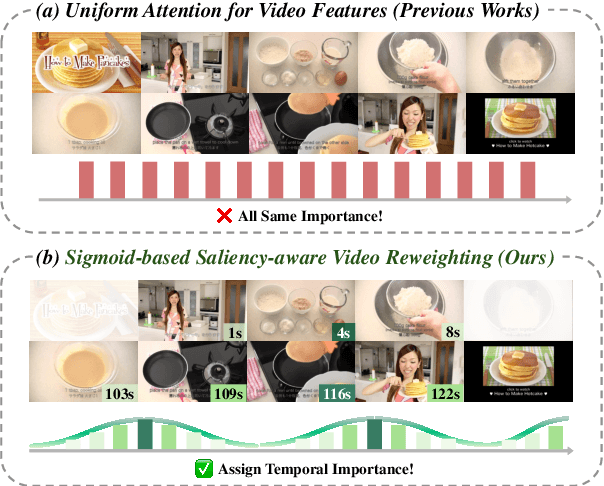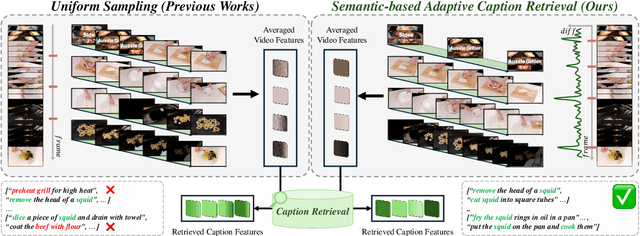Ye-Chan Kim
Sali4Vid: Saliency-Aware Video Reweighting and Adaptive Caption Retrieval for Dense Video Captioning
Sep 04, 2025



Abstract:Dense video captioning aims to temporally localize events in video and generate captions for each event. While recent works propose end-to-end models, they suffer from two limitations: (1) applying timestamp supervision only to text while treating all video frames equally, and (2) retrieving captions from fixed-size video chunks, overlooking scene transitions. To address these, we propose Sali4Vid, a simple yet effective saliency-aware framework. We introduce Saliency-aware Video Reweighting, which converts timestamp annotations into sigmoid-based frame importance weights, and Semantic-based Adaptive Caption Retrieval, which segments videos by frame similarity to capture scene transitions and improve caption retrieval. Sali4Vid achieves state-of-the-art results on YouCook2 and ViTT, demonstrating the benefit of jointly improving video weighting and retrieval for dense video captioning
SynC: Synthetic Image Caption Dataset Refinement with One-to-many Mapping for Zero-shot Image Captioning
Jul 24, 2025



Abstract:Zero-shot Image Captioning (ZIC) increasingly utilizes synthetic datasets generated by text-to-image (T2I) models to mitigate the need for costly manual annotation. However, these T2I models often produce images that exhibit semantic misalignments with their corresponding input captions (e.g., missing objects, incorrect attributes), resulting in noisy synthetic image-caption pairs that can hinder model training. Existing dataset pruning techniques are largely designed for removing noisy text in web-crawled data. However, these methods are ill-suited for the distinct challenges of synthetic data, where captions are typically well-formed, but images may be inaccurate representations. To address this gap, we introduce SynC, a novel framework specifically designed to refine synthetic image-caption datasets for ZIC. Instead of conventional filtering or regeneration, SynC focuses on reassigning captions to the most semantically aligned images already present within the synthetic image pool. Our approach employs a one-to-many mapping strategy by initially retrieving multiple relevant candidate images for each caption. We then apply a cycle-consistency-inspired alignment scorer that selects the best image by verifying its ability to retrieve the original caption via image-to-text retrieval. Extensive evaluations demonstrate that SynC consistently and significantly improves performance across various ZIC models on standard benchmarks (MS-COCO, Flickr30k, NoCaps), achieving state-of-the-art results in several scenarios. SynC offers an effective strategy for curating refined synthetic data to enhance ZIC.
SIDA: Synthetic Image Driven Zero-shot Domain Adaptation
Jul 24, 2025Abstract:Zero-shot domain adaptation is a method for adapting a model to a target domain without utilizing target domain image data. To enable adaptation without target images, existing studies utilize CLIP's embedding space and text description to simulate target-like style features. Despite the previous achievements in zero-shot domain adaptation, we observe that these text-driven methods struggle to capture complex real-world variations and significantly increase adaptation time due to their alignment process. Instead of relying on text descriptions, we explore solutions leveraging image data, which provides diverse and more fine-grained style cues. In this work, we propose SIDA, a novel and efficient zero-shot domain adaptation method leveraging synthetic images. To generate synthetic images, we first create detailed, source-like images and apply image translation to reflect the style of the target domain. We then utilize the style features of these synthetic images as a proxy for the target domain. Based on these features, we introduce Domain Mix and Patch Style Transfer modules, which enable effective modeling of real-world variations. In particular, Domain Mix blends multiple styles to expand the intra-domain representations, and Patch Style Transfer assigns different styles to individual patches. We demonstrate the effectiveness of our method by showing state-of-the-art performance in diverse zero-shot adaptation scenarios, particularly in challenging domains. Moreover, our approach achieves high efficiency by significantly reducing the overall adaptation time.
VerbDiff: Text-Only Diffusion Models with Enhanced Interaction Awareness
Mar 20, 2025Abstract:Recent large-scale text-to-image diffusion models generate photorealistic images but often struggle to accurately depict interactions between humans and objects due to their limited ability to differentiate various interaction words. In this work, we propose VerbDiff to address the challenge of capturing nuanced interactions within text-to-image diffusion models. VerbDiff is a novel text-to-image generation model that weakens the bias between interaction words and objects, enhancing the understanding of interactions. Specifically, we disentangle various interaction words from frequency-based anchor words and leverage localized interaction regions from generated images to help the model better capture semantics in distinctive words without extra conditions. Our approach enables the model to accurately understand the intended interaction between humans and objects, producing high-quality images with accurate interactions aligned with specified verbs. Extensive experiments on the HICO-DET dataset demonstrate the effectiveness of our method compared to previous approaches.
 Add to Chrome
Add to Chrome Add to Firefox
Add to Firefox Add to Edge
Add to Edge